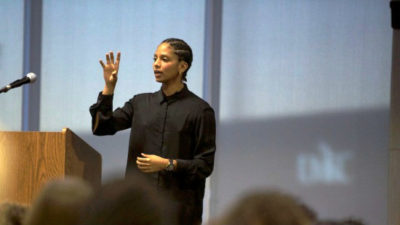International Organizer Discusses Inclusive Black Lives Matter
Janaya Khan, the powerful, knowledgeable, funny and engaging co-founder of Black Lives Matter (BLM) Toronto, breathed life into what many in the audience knew: Black Lives Matter is a legitimate, peaceful movement fighting for the “soul of black people.”
Khan (Pronouns: They | Them | Theirs) has become a leading voice in the global crusade. Known as “Future” in the Black Lives Matter movement, they is a black, queer, gender-nonconforming activist, staunch Afrofuturist, social-justice educator and boxer based in Toronto, Canada.
They spoke at the 10th Annual Pride Lecture at the University of Missouri-Kansas City, sharing details about their protests nationally and internationally. The protests are for equality, justice and social transformation, and they support people of color anywhere they’re invited, having traveled to numerous places including Pakistan to support some of its oppressed citizens.
“Two years ago after the murder of Mike Brown in Ferguson, Mo., I called for a protest in Toronto, and a total of 13 people came; four of them were children,” Khan said. She and the audience laughed. “We protested in front of the U.S. Consulate in Toronto.”
After the acquittal of George Zimmerman in the shooting death of Trayvon Martin, Alicia Garza posted on Facebook: “Black people. I love you. I love us. Our lives matter, Black Lives Matter,” which Patrisse Cullors then shared with the hashtag #BlackLivesMatter. BLM was born. Garza and Cullors, along with Opal Tometi, are the founders of BLM.
“I was not happy with the name, and I didn’t want to say it or use it. I wanted it to be something like Black Panther Cub,” Khan said. “I did something drastic. I spray painted the three words on my bedroom wall – repeating them over and over. I got it. I am now grateful for those three words, ‘Black Lives Matter.’ ”
When Khan put out a call out for protestors after BLM was established, 3,500 people showed up in just 24 hours. Things had changed for her. Under the framework of BLM, more people came out.
Khan encouraged marginalized groups to unite and work together. LGBTQIA and transgender men and women are often omitted from conversations and not given job opportunities.
Khan said the 2015 Pride protest started as resistance to police brutality – by black, gay men, and Latino and black trans women. “When BLM Toronto protested at the Pride Parade – now predominantly for white gay men – we were told to ‘stay in our lane.’ Khan said while the movement is called BLM, it’s a fight for all people who are marginalized.
“Black people have to arm themselves psychologically each day. How many times do students arm themselves to go into a classroom?” they asked. “I am afraid for the black women in their 50s and 60s who develop cancers or have strokes for no known reason, often because of their treatment in their communities and in the workplace.”
They said it’s now the moment of mass mobilization. During the protests in Ferguson, people from Pakistan texted messages to protestors telling them how to neutralize tear gas.
“I knew then that law enforcement was training across borders. The same tactics, the same strong tear gas they used on ISIS, they use on Blacks in America,” Khan said.
Khan and other members of BLM went to Standing Rock, North Dakota, to stand in solidarity with “our indigenous brothers and sisters” in their opposition to the Dakota Access Pipeline. The narrative: they are called land protectors fighting for land. We are called protestors.
“Some of the people didn’t want us there because they said we create problems, bringing out law enforcement once they learn we are a part of a protest. We are again ‘just protestors,’” they said. “Water is life, and it speaks to the quality of life. Blacks and indigenous people. Stolen land allowed for stolen labor.”
One million people checked in online to stand with the Native Americans, and contributors helped them raise $1 million. Khan asked: When would a black organization be successful? What are the circumstances that would allow us to be successful? How can we build a movement to have the same type of success? What would it mean if one million people supported BLM?
“Our skin has been weaponized. We are fighting for justice in remarkable times. Our job is to change things, to make things better and to inspire the generations to come,” they said. “Use your imagination to fight – imagine disrupting, imagine shackles on black wrists, imagine borders, imagine prisons. Someone did, and we now have each of their ideas in our reality. We must fight for the liberation of black people. We are fulcrum of the struggle,” Khan concluded.
Since 2007, the UMKC Division of Diversity and Inclusion Pride Lecture Series has brought LGBTQIA thought leaders from across the country and globe to Kansas City, including Dustin Lance Black, Laverne Cox and Ari Shapiro.

